The bonnet macaque, also known as Zati, is a fascinating and captivating species of macaque, that lives in deep forests of Southern India, recognized by the hair on the crown of its head. Endemic to Southern India, the species is similar to rhesus macaque from North India. In this article, we will delve into the world of bonnet macaques, and find out 6 important facts about the species.

Table of Contents
The Bonnet Macaque- In a Glimpse:
| Common Name: | Bonnet Macaque |
| Scientific Name: | Macaca radiata |
| Other Names: | Zati |
| Group Name: | Troop, Cartload or Tribe |
| Adult Length: | 34-60 cm |
| Adult Weight: | 2.5-12 kg |
| Tails Length: | 48-70 cm |
| Colour: | Greyish-brown to golden-brown |
| Lifespan: | 35 Years |
| Distribution: | Southern India |
| Habitat: | Dry and deciduous forest near human settlement |
| Characteristics: | Diurnal, both terrestrial and arboreal, excellent swimmer |
| Family Structure: | Live in groups |
| Diets: | Leaves, fruits, seeds, insects etc. |
| Predators: | Pythons, tigers, leopards, eagles, and feral dogs. |
| IUCN Status: | Vulnerable |
6 Facts About Bonnet Macaque:
Scientific Classification:
| Domain: | Eukaryota |
| Kingdom: | Animalia |
| Phylum: | Chordata |
| Class: | Mammalia |
| Order: | Primates |
| Suborder: | Haplorhini |
| Infraorder: | Simiiformes |
| Family: | Cercopithecidae |
| Genus: | Macaca |
| Species: | Macaca radiata |
Physical Description:
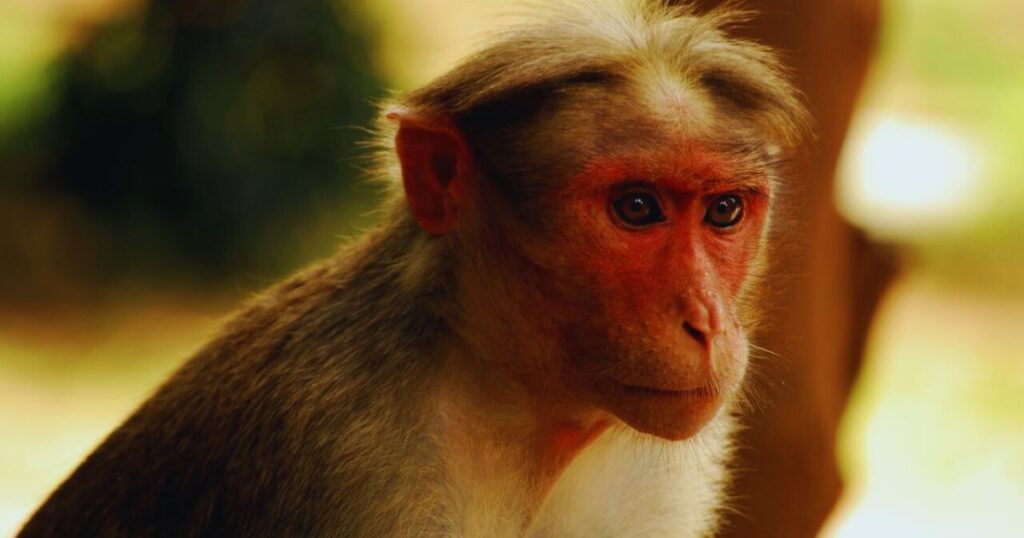
There are two different subspecies of the bonnet macaque. The subspecies differ in the colour of the belly- dark-bellied and pale-bellied. The macaque species have a whirl of hair spreading from the centre of the head. The colour of fur varies from greyish-brown to golden-brown. They have hairless faces, which seem pink in the females.
The macaque species is smaller than other macaques. Sexual dimorphism is present in the species as the males grow larger than the female. The males have a head-body length of 50-60 cm with 50-70 cm tails whereas females are 34-52 cm long with 48-64 cm long tails. The male macaques are weighing between 5 and 12 kgs whereas females weigh 2-5.5 kg.
Lifespan:
In captivity, bonnet macaques usually live 35 years. In the wild, due to diseases, encounter with predators, conflict with humans and hunting, they usually live between 20 and 25 years.
What are the differences between the bonnet macaque and the rhesus macaque?
| Characteristics | Bonnet Macaque | Rhesus Macaque |
| Distribution | Southern India | Northern India |
| Size | Larger | Smaller |
| Canine Teeth | Smaller | Larger |
| Group Size | 30-40 members | 60-70 members |
Distribution and Habitat:
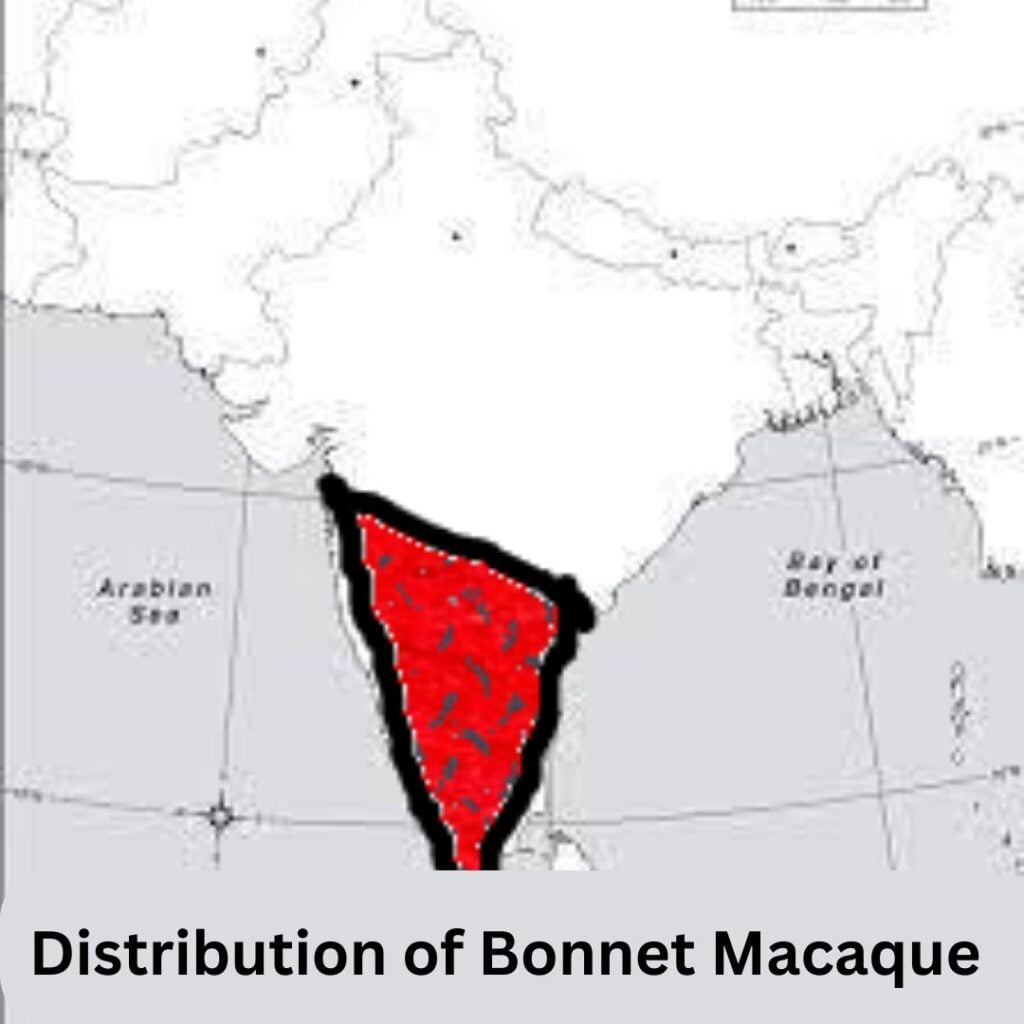
The populations of bonnet macaque are endemic to South India usually in Maharastra, Karnataka, Goa, Andhra Pradesh, Telangana, Tamil Nadu and Kerala.
The dark-bellied macaques live in evergreen and deciduous forests, in urban areas and in tourist places and on the outskirts of villages. The comparatively rare pale-bellied macaque, southern coast of India and in the Western Ghat mountain range and Pondicherry.
The ability to live commensal with humans poses a big threat to the monkey. Studies have reported that the decline of its population is faster than what is assumed before due to conflicts with humans and hunting.
Behaviour:
The bonnet macaques are diurnal as well as arboreal and terrestrial quadruped, which means they live on both ground and on trees. They spend most of their time on the ground to find food, either by foraged or hand-fed by humans. The macaques roam around in the canopy of Southern India, stabilized by their ability to keep three or more limbs in contact with branches at all times.
Humans and bonnet macaques love to interact with each other. The dark-bellied macaques are usually found in tourist places, temples, and villages and they rest on trees near humans are available. Many villagers sell fruits and vegetables to tourists for the sole purpose of feeding the macaques.
Daily Life and Social Structure:
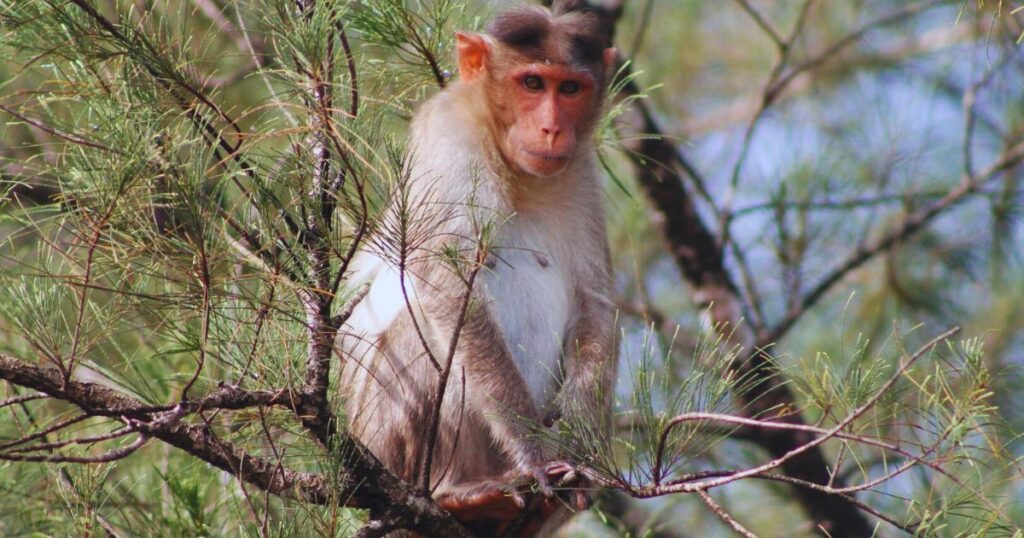
The macaques live in groups of 30+ individuals, organized in a linear, age-ranked order. Males are usually dominant over females. Sometimes brutal encounter happens to get access to reproduction. Higher-ranked males have the first chance to breed with females Unlike other macaque species, a special type of allogrooming is seen in the macaque species. The senior members of the troops groom the junior members and all members participate in this bonding activity.
The male members often emigrate from the natal group to gain higher positions in the troops whereas the females (except pale-bellied female macaques) usually remain in the same group. Being a diurnal species, the species is more active during sunlight than at night. At night or while resting same-sex macaques stays closer to each other and the dominant male grabs the juvenile tightly with his arm.
Communications:
The bonnet macaques are very social animals and often communicate in wide ranges of facial expressions and gestures which can be easily differentiated. Lip-smacking is one of the most common and important affiliative behaviour where an individual opens or closes their mouth in open succession and tongue between their teeth and lips pressing against each other with producing an audible sound.
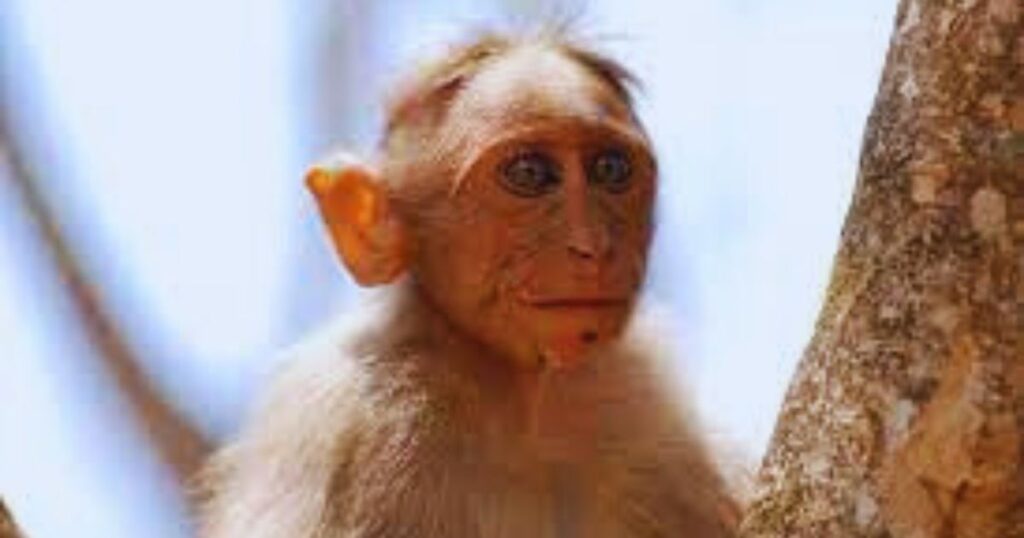
A grimace is another common behaviour which indicates fear or submission by a junior while facing an aggressive encounter with dominant males. A grimace gesture is like pulling back the upper lips and showing the upper teeth. Another expression is “grinning and clicking” to express relief from tension which includes a wide grin and repeating clicking on the tongue. When two large and dominant males meet, they also show an “Embrace” behaviour to show affection and love to each other.
Females usually don’t show much sexual willingness as they have little sexual swellings. Older dominant males mate with the same female for several days whereas the younger ones change their partners in the timespan.
Reproduction:
| Breeding Season: | February- April |
| Breeding Interval: | Once a Year |
| Sexual Maturity: | 3-4 Years |
| Sexual Orientation: | Polygynandrous |
| Gestation Period: | 165-170 days |
| Litter Size: | 1 |
| Weaning Age: | 6-7 months |
| Age of Independence: | 9-12 months |
The bonnet macaques reach sexual maturity at the age of 3-4 years. The breeding season differs for dark-bellied and pale-bellied macaques but usually, the birth takes place before arriving monsoon or between February and April or early May and the breeding takes place once a year.
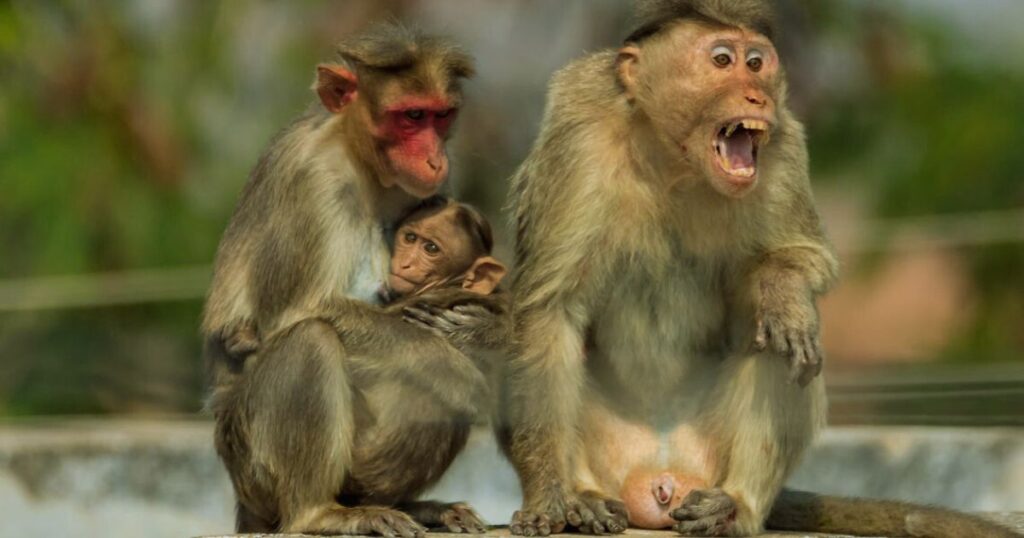
The macaques are polygynandrous or have a multi-male and multi-female mating system. The dominant and senior males usually mate with a particular female for several days whereas the sub-ordinate males don’t have any fixed partners. The females also mate with males promiscuously similar to other macaque species.
The gestation period for bonnet macaque is primarily 165-170 days or 24 weeks whereas the average litter size is 1. Sometimes, twin infants are also born. The infants breastfeed for the first 6-7 months and onwards their mother starts to feed them solid food. Other members of the troops, closer to the mother, shows alloparenting (care provided by other individuals other than parents) to the infant for the first month of his life.
Diets:
The bonnet macaques are primarily herbivorous although it feeds on invertebrates and small insects. The macaques also feed on flowers, nuts, seeds, cereals and flowers. As the macaques love to exist near humans, they also like to eat what humans offer them and they also raid the crops and confront with farmers and villagers.
Ecological Impact:
As the diet of the macaques relies on fruits, vegetables and seeds, they help in tree propagation by dispersing seeds.
Threats:
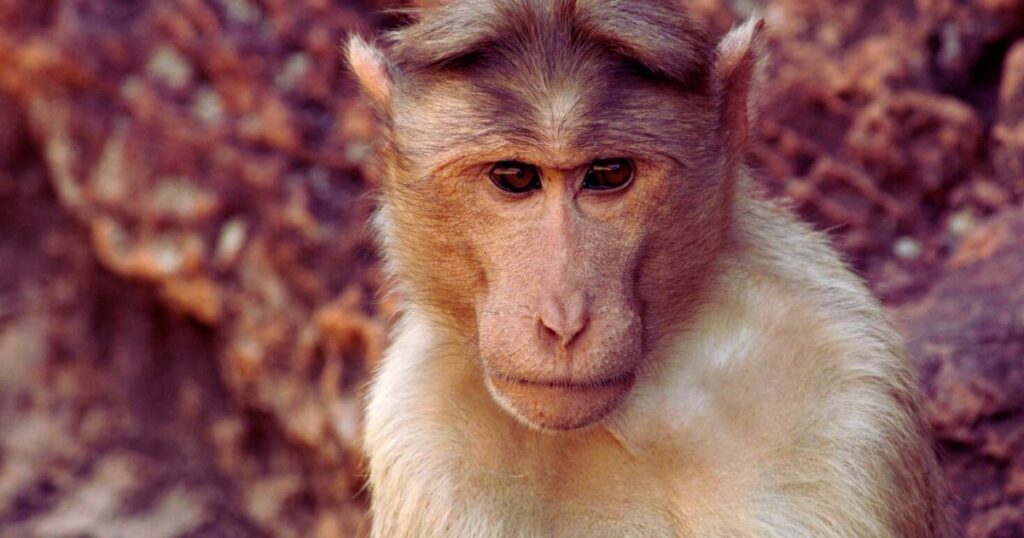
The bonnet macaque has undergone a massive decline over a period of last 40-50 years. The major causes which lead to its population loss are hunting, ill-treatment, faulty translocation, road expansion, decline of forests in the region etc.
The macaque species is treated as a pest to the crops. They become aggressive and destructive while searching for food. While raiding crops, they often encounter farmers and villagers and it causes harm to the little macaque species. Like the other macaques, Bonnet macaques are hunted to sell as pets or objects for research in Western Countries at a high price.
Predators:
Although the macaque species is very agile and elusive yet some of the known predators include, pythons, tigers, leopards, eagles, and feral dogs.
Conservation Status:
The bonnet macaques are listed as vulnerable in the IUCN Red List of Threatened Species.
Frequently Asked Questions (FAQs):
Is Bonnet Macaque Friendly?
Yes, bonnet macaques are friendly until you threatened them. They usually live in temples, villages and closer to human settlements. They love to feed on food and crops offered by humans.
Why are bonnet macaques endangered?
The number of bonnet macaques decreasing rapidly over the last 40-50 years. But the species is listed as “vulnerable” in the IUCN Red List of Threatened Species.
What are the predators of bonnet macaque?
Pythons, tigers, leopards, eagles, and feral dogs are some known predators of bonnet macaque. Although the macaque species is very agile and elusive and hard to catch.
Why do macaques show their teeth?
Bonnet macaques love to communicate with various gestures. One of the gestures is grimacing or showing teeth. The gesture is shown by juniors to the dominant males as a sign of fear and submission during an aggressive encounter. It includes pulling back its upper lip and showing its upper teeth.
Are macaques invasive?
Usually, macaques are not invasive species but in some parts of the world Genus Macacas have become invasive. The long-tailed macaque is an invasive species in Mauritius and rhesus macaque is invasive in Florida.
Also Read: Northern Plains Gray Langurs: 6 Interesting Facts